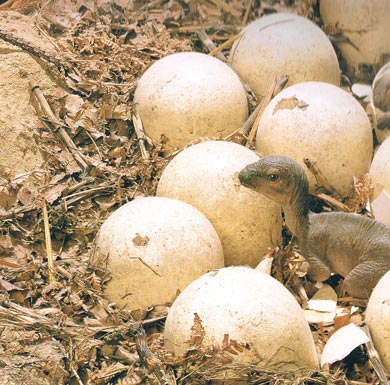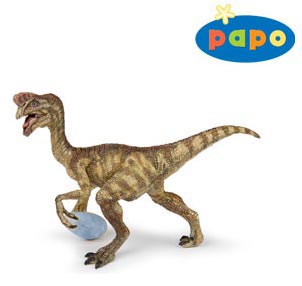Dinosaurs May Have Laid Coloured Eggs
New Research Suggests Colourful Dinosaur Eggs
Birds today lay many different sized eggs, the New Zealand Kiwi (genus Apteryx), for example, lays an egg that is up to 25% of its entire bodyweight. The Kiwi lays the biggest egg in proportion to its body size of any living bird. The Bee Hummingbird (Mellisuga helenae), which we at Everything Dinosaur believe to be the smallest species of bird alive today, lays an egg that is not much bigger than a garden pea.
Palaeontologists know that dinosaurs laid different sized eggs too. The eggs of a giant titanosaur being many times bigger than the eggs of a small dromaeosaurid.
Dinosaur Eggs
Images released show a selection of the 3,000 dinosaur eggs taken off smugglers by Chinese customs officials. The pictures nicely illustrates the huge variety of dinosaur egg size and shape.
However, birds today lay eggs not only of different sizes but of many different colours as well and until recently there had not been much research undertaken as to the pigmentation of dinosaur eggs.
Scientists had studied melanosomes to uncover information about feather colour in the Dinosauria, but little work had been undertaken to assess the potential colours of dinosaur eggs. For many years, scientists had assumed that dinosaurs and primitive birds laid plain, white eggs which were most certainly not coloured. Intriguingly, if you look at pictures of dinosaur nests as illustrated in many dinosaur books, the eggs tend to be coloured pale or almost white
The Convention is to Colour Dinosaur Eggs White or Pale
Coloured Eggs
Pale or white coloured eggs would not necessarily help with camouflage, especially when you consider that due to the size of some of those dinosaur mothers, they could not have laid eggs in a secluded, hidden location. The chances are that many dinosaurs laid eggs in open and exposed places, hence the need to breed in colonies to afford some protection to their offspring. Two new studies have shed some light on the potential colour of dinosaur eggs, suggesting that they might have been blue-green instead of pale or plain white.
One study conducted by scientists at Bonn University (Germany) discovered that two pigments that provide colour for extant bird eggs also existed in the eggshells of an oviraptorid dinosaur from China called Heyuannia huangi.
Heyuannia huangi
H. huangi, was typical of the Oviraptoridae. Fossils of several individuals have been excavated from Upper Cretaceous sediments in Guangdong Province (southern China). The fleet-footed dinosaur was most probably feathered and measured a little over 1.5 metres long when fully grown (about 40% of its body length was made up of its tail)
Thousands of small theropod eggshell fragments have been found in association with the body fossils and it is thought that the sediments represent a H. huangi nesting site. The German study, which has yet to be peer-reviewed, concludes that the two pigments protoporphyrin and biliverdin, responsible for colouring chicken eggs brown and the eggs of emus and other birds blue, were present in the eggshells of this dinosaur. The German scientists also related egg colour to the type of nesting habit of the bird concerned. Birds that lay more open, exposed nests tend to have specific egg colours to help camouflage the eggs.
The team suggest that based on this evidence, dinosaurs such as oviraptorids that laid open nests may have laid eggs that were camouflaged. Heyuannia huangi for example, could have laid blue/green eggs of a similar colour to that of an emu’s egg. The researchers also propose that the discovery of eggshell pigments may have implications on how the adult dinosaurs looked after the nests. Behaviours similar to extant birds could perhaps be inferred.
Mapping Pigments
This research builds upon an earlier study undertaken by a team of animal behaviourists at Hunter College in New York. Professor Mark Hauber, one of the lead authors of the scientific paper, published recently in the academic journal “Biology Letters”, and his team effectively mapped the presence of two pigments protoporphyrin and biliverdin and used the way they combine with each other and blend with the calcium carbonate of the eggshell to predict egg colour.
The New York based team produced a series of computer models that plotted the ways in which these two pigments combine in various ratios and used these models to work out what colour eggs would occur as a result.
Taken together these two studies suggest that different types of dinosaurs may have laid different coloured eggs just as birds do today. In addition, it seems that the ability to lay camouflaged eggs goes back a long way into the Mesozoic, with the dinosaurs evolving this ability which was then inherited by the Aves.
Oviraptorids May Have Laid Coloured Eggs
Picture credit: University of Bonn/PeerJ
Everything Dinosaur and Coloured Eggs
A spokesperson from Everything Dinosaur commented:
“Given the great many hues and colours seen in modern Aves it makes sense that ground-nesting dinosaurs in open environments would have produced eggs that enabled them to blend in with the background of the nest. Colours seen in fossils, such as the oviraptorid eggs from China pictured above, however, do not normally reflect the actual “true” colours as they would have been in life. Colouration of the fossil is strongly influenced by the permineralisation process and so readers should not be deceived into seeing fossils of different colours and assuming that is what they were like when, as in this case, the eggs were laid.”
Could it be time for Papo, to change the colour of the dinosaur egg that their model Oviraptor is grasping in its claws?
The Papo Oviraptor Model (with Egg)
Picture credit: Everything Dinosaur
To visit the Papo models section of the Everything Dinosaur website: Papo Prehistoric Animal Models.




